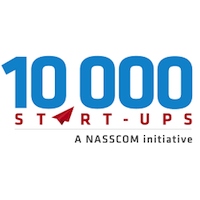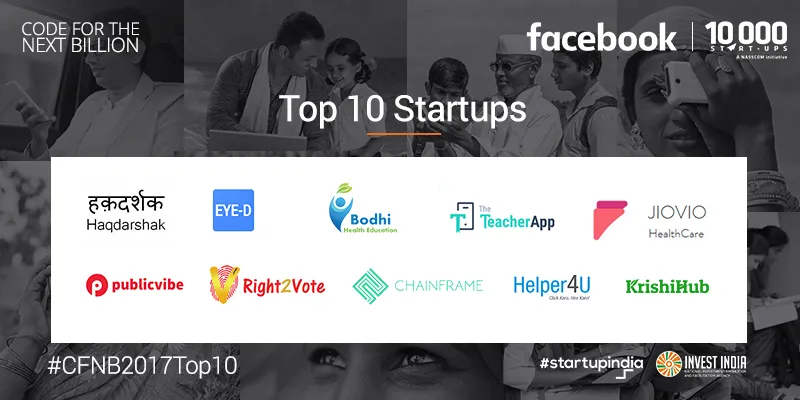
Nasscom 10 000 Start-ups
View Brand PublisherWhy inclusive technologies and regional languages will be the key focus for Indian startups to cater to the new billion users
The power to redefine the lives of a billion people and more lies within the now ubiquitous device we all know as the smartphone.
This is the belief guiding the 10 Indian startups who have been shortlisted for the 2nd edition of the Code for the Next Billion programme, a joint initiative by Facebook and NASSCOM 10,000 Startups, to meet the varied challenges and developmental obstacles in India using innovative solutions.

Though their offerings may be varied, what unites these entrepreneurs is their resolve to drive change through technology. For them, the smartphone is akin to an ‘astra’ or a weapon to fight inequity and poverty, and catalyse development for the next billion digital users across sectors such as healthcare, education and governance.
How technology and access to mobile phones is making quality healthcare achievable
When SenthilKumar, Co-founder, JioVio, met a new mother who had just delivered a baby, he was shocked to know that despite there being manual records of her “visits” to the primary healthcare centre in her village, she hadn’t visited the centre even once during her pregnancy.
To tackle the problem of such falsified health records, plug vital gaps and make quality maternal healthcare accessible to those who most need them, JioVio has developed a wearable device which tracks the health of expectant mothers. They have also partnered with non-profits who have a network of doctors and primary health care workers on-ground. “In 2017, we piloted the device in four Kerala villages -- Kalpetta, Wayand, Vellaram Kunnu, and Anandavadi. Following this, we noticed that there were no maternal deaths in these areas, and also observed that the health of the newborn was drastically better.”
Today, they have access to 100 villages across India. Senthil says, “Today, we see smartphone penetration and internet connectivity improving drastically in rural areas where even road connectivity is absent. Also, there is an increased awareness about using mobile phones and apps even among those at the bottom of the pyramid. So training people to use our apps and the wearable device isn’t a challenge. Once the primary health care workers are trained and given access to the device, the model becomes sustainable and is able to run with minimal intervention.”
Bodhi Health is another startup working to improve healthcare in India. Abhinav Giridhar, Co-founder, says, “We believe that healthcare in India can be significantly improved if we can improve the knowledge and awareness among health professionals and community health workers. While this thought has been the prime mover of many motivated organisations in India, today with the aid of technology, the interventions can be magnified significantly.”
They offer courses in clinical settings by partnering with healthcare institutions to enable practical learning, and use simulation and scenario-based games to enhance the learners’ decision-making skills. Starting as B2B model, where courses were offered in partnership with hospital chains and clinics as part of their induction process for freshers, the startup now has a B2C offering that can be accessed by health workers across the country. While their courses are platform-agnostic, they see nearly 90 percent of their e-courses being consumed on the mobile. Abhinav says, “We have seen about 65 per cent of our traffic coming from tier 2 and 3 cities as well as semi-urban areas. It doesn’t come as a surprise that they are unanimous in the preference of device to consume our courses – the mobile. In addition to enabling an ‘anytime anywhere learning mode,’ a mobile device scores positively from an affordability perspective.”
Bringing transparency in governance and civic management
Another area where technology can make a huge difference is governance. Being closely involved in the election campaign management as part of Citizen for Accountable Governance (CAG), Neeraj Gutgutia, Founder, Right2Vote, says, “We calculated that if we can plug in technology we can reduce the cost of holding an election by at least 90 percent, time by 99 percent and human effort in election management by 99.9 percent.”
So Neeraj founded Right2Vote, which is today one of the leading e-voting apps for government elections, corporate elections, housing society elections and even school and college elections. “We want to bring transparency and accountability at all levels. This is where a simple device like a mobile can make all the difference, that too in a country like India where there are a billion mobile users.”
Leveraging the power of mobile phones and the app economy to address civic issues is another startup – Haqdarshak. Aniket Doegar CEO, and Co-founder, says, “We are working to ensure that various public and private welfare schemes are accessed by those who are entitled to and need it the most – often the poor, illiterate or semi-literate, rural citizens.”
Haqdarshak has created an app which has a rich and accessible database of thousands of public and private welfare schemes in the country – all in regional languages. The app also screens the applicant to find out which schemes he or she is eligible for. Village-level facilitators enable the applicant to apply for and receive the benefits, via the app. In the past, these facilitators could only apply for generic schemes, without checking exact eligibility which limited their reach. Aniket says, “The difference is that now with the app, the facilitators are able to reach out to more people.” Today Haqdarshak has a network over 1500 on-ground facilitators across 10 states in the country and have processed 20,000 applications for various welfare schemes in a span of 24 months, since its launch in 2016. The startup has recently launched a beta version of a public portal which allows citizens to check their eligibility and learn about the various welfare schemes through video tutorials. The portal will be ready for public launch by the end of March, according to Aniket.
Nitin Shukla, CEO, ChainFrame believes that technology can bring about fundamental changes in governance in a country like India. ChainFrame is leveraging blockchain technology to solve systematic, process-oriented problems in governance. Abhinav Nayar, co-founder, explains, “We care deeply about improving the quality of public institutions in practical ways. For example, State governments spend thousands of crores on welfare schemes but there are major challenges in implementation. The time taken from the announcement to actually reaching the intended beneficiary can take many months, diluting their impact.”
Technology like blockchain can bring in efficiency in governance especially where payments are involved, say the two entrepreneurs. Nitin says, “Blockchain is a foundational technology that is appropriate for public finance, with benefits like more informed decision-making, live tracking, immutable security, and automation. We want to be the backbone for governance activities at all levels, starting with welfare scheme management.”
Nitin admits that a new technology like blockchain needs some education to be accepted in government circles. But, he adds, “There is a lot of buzz around emerging technologies, so it takes some effort to separate the signal from the noise. The good thing is leaders now are more open to integrating technology than in the past. We have received interest from both large and small states, in different parts of the country and abroad.”
Helping teachers learn to teach better
“If we have to improve the educational outcomes of the 250 million children who study in government and small-budget private schools, we need to enhance the quality of teachers,” says Vinod Karate, CEO and Co-founder, TheTeacherApp.
The app offers courses on concepts of maths, language teaching and other progressive ideas to teachers over a smartphone. The platform has dedicated discussion forums for teachers to connect with their peers. They also offer podcasts by experts and access to educational toolkits.
Vinod says, “The ability to reach teachers directly through smartphones is as crucial as quality content. Each course requires less than 50 MB data and runs offline, making it accessible anywhere, anytime. This also gives teachers options to personalise the learning as per their requirement. None of this would have been possible if not for the increasing penetration of smartphone and internet connectivity.”
Defining an India of a new billion
Meenakshi Jain, Founder and CEO, Helper4U says, “I would divide the next billion into the rural poor and the urban poor. Working closely with the urban poor, we have observed that their aspirations and needs are the same as the urban rich, though on a smaller scale: education for their kids, good jobs, a decent place to live in, accessibility to loans, and interest in electronic consumables like mobiles, two-wheelers and household electronics.”
But, unlike the urban rich, fulfilling these aspirations becomes challenging for the urban poor, most of whom are unskilled or uneducated workers, says Meenakshi. “Most often the root causes of the challenges are lack of access to information and networks. These uneducated job seekers, including domestic workers are often victims of physical and financial abuse in the absence of a collective. The accepted norm to find a lead is to pay commissions to middlemen, agencies or the security guards of apartments, offices, or gated communities. All this makes their lives harder than what it already is. On the other hand, employers found it equally challenging to find a reliable help in their vicinity.”
By founding Helper4U, Meenakshi aims to address these on-ground challenges. The online platform connects job seekers at the bottom of the pyramid with employers at homes and offices in over 100 Indian cities. Helper4U has automated the process of hiring while helping the job seekers find better job opportunities, with dignity, near their homes. Helper4U also has an app H4UConnect which makes disbursing leaves, monthly salaries and keeping the document check in place easy for both the employers and helpers.
Jyotiska Khasnabish Co-Founder and CTO of KrishiHub, agrees with Meenakshi’s view on technology being a key enabler. Starting off their entrepreneurial venture as a B2B demand-driven platform first, which enables farmers to sell their crops directly to different businesses like restaurants, hotels and large cafeterias, they are now working towards building technology platform for crop advisory and agri inputs through their mobile app.
Jyotiska says, “Traditional methods of education or infrastructure have not been able to solve agricultural problems or improve the socio-economic status of farmers even after decades of interventions. This is where technology can prove to be a game-changer. Using a mobile application with a working internet connection, it is possible to deliver customised information on relevant areas such as crop price discovery and forecast, location-specific listing of farm equipment sellers, organic crop cultivation, etc., to farmers across India. By empowering the farmers with the right information and complementing that with a viable demand-driven platform, we are working towards improving the socio-economic status of the farmers. ”
Working closely in the agricultural sector, Jyotiska predicts that there will be a reversal of trend with regard to the interest in agriculture among the new billion. He says, “We are seeing highly educated youngsters with technological backgrounds going back to agriculture. This generation will leverage technology, embrace sustainable farming principles, and will go on to prove that farming can be viable if done right.”
Another area where technology has been acting as a great leveller is in the development of solutions for differently-abled citizens, of which the visually-impaired constitute a significant section.
According to the World Health Organisation (WHO), an estimated 253 million people globally have vision impairment, and India houses the maximum number. EYE-D is a startup working on solutions that help the visually-impaired lead independent lives. Gaurav Mittal, Co-founder, EYE-D says, “Today the world runs on smartphones. But how often do you see blind people being able to use one? Smartphones do have a few accessibility features, but these are often unexplored and also not enough.”
EYE-D has built a standalone solution that leverages the advantages offered by a smartphone to provide location support, help in exploring nearby places, identify colours and read printed text, such as medicine labels, to help the visually-impaired manage their daily activities with ease.
The EYE-D app has 10,000 active users from 160 countries. About 60 percent of the users are from India. Gaurav says, “The visually impaired will constitute a big number in the next billion, if not for a significant percentage. We will witness a strong preference for support in regional languages. This means our technology should be able to read street signs, product labels, and respond to verbal commands in regional languages. Another point that we need to be attentive to is the fact that this billion will embrace a solution that is easy to comprehend. The simpler, better the chances of it being adopted at scale.”
Narasimha Reddy, CEO and Founder, PublicVibe, shares similar opinions, “So far, hyperlocal news in regional languages was often ignored and its importance negated. But, that could soon change, with the next billion consumers becoming a key growth driver.”
A vernacular hyper local community news platform, PublicVibe allows public to share hyperlocal news, issues and experiences. “Hyper local news like water clogging, accidents, open manholes, adulterated food, polluted water etc. in the neighbourhood can impact daily life but it is not possible for traditional media to disseminate such information. Public Vibe is addressing this gap by focusing on publishing exclusive local updates which often do not make it national and regional media.”
And, because it is available in vernacular languages and is mobile-friendly, it becomes easy for people in tier 2 and 3 cities and rural areas to not just consumer content but also become citizen journalists. With more than a million downloads, Public Vibe is seeing faster adoption and growing to be an alternative platform for the next billion to voice and share news and opinions that is important to them.
An enabler in this journey
As they continue to put in significant effort to change the lives of a billion, these entrepreneurs stress on the fact they need mentors who can guide them on aspects ranging from cyber security to technology to marketing. They also say that funding, industry connects and partnerships are crucial to strengthen their movement. And, it is here that a programme like the Code for the Next Billion will play a defining role.
Neeraj from Right2Vote aptly summarises the mission that the 10 startups are on. He says, “With a smartphone and the power of internet in their hands, the next one billion can skip many decades of developmental gap and directly come at par with the ‘first billion’. We want to make that happen. And here we want to leverage the expertise and network of NASSCOM, Facebook and other industry organisations who have directly and indirectly impacted a billion people.”







